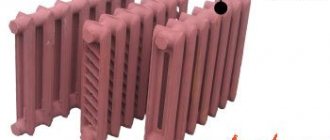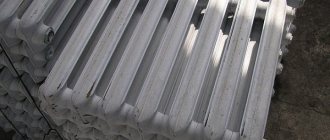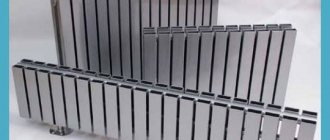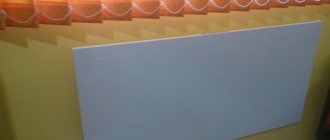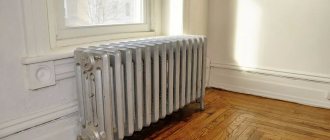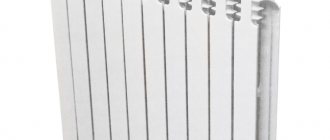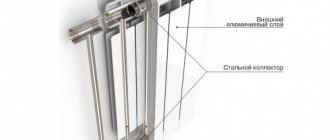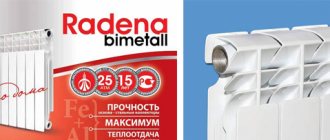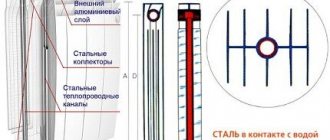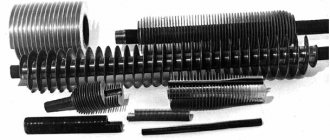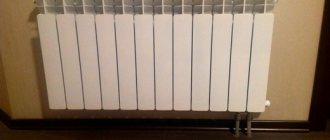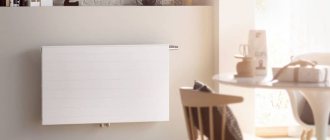The characteristics of cast iron radiators differ from those characteristic of models made of steel and bimetallic raw materials. Models of such batteries, although old, still do not lose their popularity due to their quality and decent technical parameters. But the debate over which is better: old Soviet or improved modern models does not subside. To sort this out, we have prepared today’s article, in which we will look at the features of cast iron radiators, and in the table we will describe the technical characteristics of different models.
Design features of cast iron radiators
Cast iron radiators are the most durable
The batteries have the most traditional appearance. The design includes several sections connected to each other by nipples. To seal the joints, heat-resistant rubber or paronite is used. The coolant channels inside have a round or elliptical cross-section. They produce one-, two- and three-channel sections.
The batteries are cast from gray cast iron. The material is wear-resistant and durable - radiators last more than 50 years. Salts are not deposited on the walls, small debris or sand does not cause damage. Even after 30–40 years, the diameter of the working channels remains almost unchanged.
The size of a cast iron battery depends on the number of sections. The size is selected based on the size of the heated room. But if the width of the product is determined by the number of elements, then the height and depth depend on the structure of the sections themselves.
The appearance of the product is unattractive. More modern models are produced with a flat front panel. Decorated with forged elements.
Coolant quality
We have already noted that cast iron batteries are absolutely insensitive to the quality of the coolant. They don’t care about its type, composition, pH and other characteristics. All foreign impurities, stones and other debris, always contained in utility networks, freely pass through the wide channels of the radiator and are sent further (possibly to get stuck in the narrow holes of the steel inserts of the neighbor’s bimetallic radiator).
For cast iron, it doesn’t matter what kind of coolant you are going to equip the system with if you plan to use it in your home. This can be water, antifreeze, or any other non-freezing liquid.
Many people conclude that when using cast iron radiators, water treatment is not needed at all. Do not follow these tips under any circumstances! There are many other components in your system, first of all, the boiler, whose power may drop due to poor quality coolant, or the heat exchanger or hydraulic group may fail.
Advantages and disadvantages
Modern design solutions
The advantages of the product are determined more by the material than by the design. Main advantages:
- Cast iron conducts heat well and accumulates it. The radiator takes longer to heat up than a steel or bimetallic one, but gives off heat for a long time after the boiler is turned off. An hour after heating stops, the residual heat transfer for cast iron models is 30%, while for steel models it is only 15%.
- The water used in central heating is not clean. Salts, mechanical impurities, sand destroy the pipeline material. Debris is deposited on the walls: the working diameter decreases over time, and the efficiency of heat transfer decreases. Cast iron is not afraid of salts and abrasive particles. After 30 years, the batteries work as efficiently as on the first day after release.
- Cast iron batteries cannot withstand constant high water pressure, but they are not afraid of water hammer. This option is used when arranging heating with natural circulation.
- Radiators last at least 50 years. If you change the gaskets on time, it will take even longer. Usually they are replaced not because of leaks or low efficiency, but to make the interior more modern.
- The price is the lowest among heaters.
Disadvantages of radiators:
- The main disadvantage is its considerable dimensions and heavy weight. The 8-section model weighs more than 60 kg. They are difficult to transport, lift to the top floor, and install.
- If when the heating is turned off, high thermal inertia acts as an advantage, then when turned on it turns into a disadvantage. The room warms up for at least 12 hours.
- To service the batteries, you need a large volume of coolant and a more powerful boiler. This is not a hindrance for central heating, since the system was originally designed to transfer a large amount of coolant. For an autonomous one, this is a significant drawback.
- There is no need to talk about design. Rough, heavy radiators hardly fit into the interior.
The advantages of a cast iron battery are well demonstrated in central heating systems. The disadvantages are visible when autonomous heating is installed.
Design Features
Water contains a large number of impurities. When in contact with aluminum, they cause corrosion. Over several years of use, these processes will lead to leakage of the device.
The design feature of these radiators is the presence of an internal stainless steel core, which is surrounded on the outside by an aluminum alloy. This way, water does not come into contact with aluminum, which significantly extends the service life of the system.
There are two manufacturing options:
- Pseudobimetal. In this case, the steel core is located only inside the vertical channels. So aluminum is not completely protected, but only in the weakest places. These models are cheaper and have a standard service life of up to 10 years if used in systems with high water pressure (for example, in city apartments).
- Bimetal. It has a solid inner casing made of steel, which is filled with aluminum alloy under pressure. Here the aluminum is protected on all sides. These are more expensive models and their service life under similar operating conditions is up to 30 years.
Design of a bimetallic battery The manufacturing method directly affects the volume of water in the section of the bimetallic radiator. If we compare it with any other battery, the volume of one section here will be significantly lower. The disadvantage is compensated by the presence of two alloys. As a result, the inner steel core prevents the aluminum shell from cooling quickly.
There are different ways to join two metals. It is preferable if aluminum is poured over steel under pressure. This battery model will last longer. There is an option when metals are joined together by welding.
According to the technical type of design, radiators can be:
- Collapsible. This means that using a radiator wrench you can unscrew any number of sections and screw them to another radiator. This type is most often installed in private houses with an autonomous heating system, where there is no high water pressure.
- Non-separable. The radiator is monolithic, it cannot be untwisted, cut, or attached to another. Perfect for use in a city apartment, where there is always a high level of pressure.
Heat dissipation of a cast iron radiator
The power of a cast iron radiator directly depends on the area of its outer surface and lies in the ability to release heat energy at the highest possible coolant temperature. Basically, this value ranges from 80 to 200 watts per section . To calculate the required power, the following formula is used: for 25-30 cubic meters. m. battery power should be 1 kW . If there are several external walls, the power indicator increases.
Power and size
Its power depends on the size of the heating device. The average heating power of a standard height cast iron radiator section is 160 W, while the power of a section of aluminum and bimetallic heating radiators is 200 W. Therefore, for high-quality heating of the room, the size of the purchased cast iron radiator must be larger than the size of the corresponding aluminum and bimetallic radiators. You can calculate the heating radiator power for your room as follows. First you need to find out the volume of the room. To do this, multiply the width by the length and the height. Length – 5 m, width – 3 m, height – 2.5. 5*3*2.5=37.5 cubic meters To heat 1 cubic meter in a standard building, 41 W of thermal power is consumed. To heat a room with a volume of 37.5 cubic meters, 37.5 * 41 = 1537.5 W will be required, i.e. approximately 1600 W. In case of extreme cold, when calculating, it is better to increase the resulting power by 15-20%. 1600+20%= 1920W = 1.92 kW Knowing the power of the heating device, we will calculate the number of standard-sized radiator sections. The power of the cast iron radiator section is 160 W. 1920:160 =11.25 i.e. 12 sections. The power of the aluminum radiator section is 180W 1920:180=10.6 i.e. 11 sections. The power of the bimetallic radiator section is 200 W 1920:200=9.6 i.e. 10 sections. The power of the steel radiator section is 140 W 1800:140 = 13.7 i.e. approximately 14 sections.
Dimensions of a cast iron radiator.
In the Soviet Union, the overall dimensions of cast iron radiators had a certain standard. In one section, the distance between the centers of the coolant supply and discharge pipes ranged from 30 to 50 cm. The width of the section was not standardized and varied among different manufacturers. Almost all modern batteries also have these standards. The most popular model among cast iron products is MS-140. (installed in many “Khrushchev” and 9-story buildings of the 60-80s). The distance between the centers of the pipes is 50 cm; battery height 58.8 cm; width 9.3 cm; depth - 14 cm. The variety of overall dimensions of batteries is explained by the needs of customers.
Battery thickness
The dimensions of bimetallic heating radiators, therefore, may be different. Their depth is usually 80 or 100 mm. Sometimes 90 mm options are also available for sale. In this case, the choice depends solely on the personal preferences of the home owners themselves. If the niche for the battery is deep, you can purchase a thicker radiator. If the wall is in the same plane as the edge of the window sill, you should, of course, buy an 80 mm radiator. In this case, if necessary, it will be easier to disguise it.
Characteristics of cast iron radiators of various manufacturers and models
In Soviet times, there were countless factories producing cast iron radiators - after all, there was no alternative. Here, for example, are just a few of their types: NM-140, NM-150, Minsk-110, R-90, RKSh. Almost all of them are no longer produced. Perhaps only one proven model lasts a long time - the MS-140, classic and good-quality.
New models look prettier; for example, the Ms-110 from the Santekhlit plant has a shallow depth (only 11 centimeters) and fits well under narrow plastic window sills.
Radiator MS - 110.
In Cheboksary they make FM radiators with one, two and three channels. Their outer side is flat, which looks quite aesthetically pleasing, and it’s easier to wipe off dust.
FM radiator models.
Beautiful two-channel radiators are produced in Minsk, about 10 models in total.
An example would be radiators 2K60P, 2K60PP, 2KP100-90-500, 2K60P-300.
Sectional batteries made of cast iron are also brought to us from abroad. Foreign products are smoother both outside and inside, so their heat transfer is higher. Let us note the Chinese company Konner (the “Hit”, “Modern” and “Fort” models are especially good).
Radiators from Konner, model Moder.
The Czech plant Viadrus, the Turkish company DemirDöküm and the Spanish concern Roca also make good radiators. European manufacturers make very elegant batteries with a cast-iron cast pattern. True, such radiators are an order of magnitude more expensive than domestic ones.
Table. Comparative characteristics of cast iron heating radiators of the most common manufacturers and models
Brand and model Section dimensions, H/W/G Operating pressure, atm Thermal power, kW Heating area by 1 section, m2 Water volume in a section, l Section weight, kg
| MS-140 | from 388 to 588/93/140 | 9 | from 0.12 to 0.16 | 0,244 | from 1.11 to 1.45 | from 5.7 to 7.1 |
| World Cup1 | from 370 to 570/80/70 | 9 | from 0.075 to 0.11 | from 0.103 to 0.165 | from 0.66 to 0.9 | from 3.3 to 4.8 |
| World Cup2 | from 372 to 572/80/100 | 9 | from 0.1009 to 0.1423 | from 0.148 to 0.207 | from 0.7 to 0.95 | from 4.5 to 6.3 |
| World Cup3 | from 370 to 570/90/120 | 9 | from 0.1083 to 0.1568 | from 0.155 to 0.246 | from 0.95 to 1.38 | from 4.8 to 7 |
| Konner Modern | 565/60/80 | 12 | from 012 to 0.15 | — | from 0.66 to 0.96 | from 3.5 to 4.75 |
We have given the main technical characteristics of cast iron heating radiators that are most often in demand. I think they helped you get the big picture.
How to choose cast iron heaters
When choosing radiators, we follow the standard algorithm. We determine the required thermal power, calculate the number of sections, and assemble heating devices for each room from them. Then - the purchase of heaters, installation kits and control valves.
What type of radiators is better to choose:
- For heating technical, utility and utility rooms of a private house, the MS-140M series or its variants are quite suitable.
- In residential premises, “accordions” are clearly inappropriate. Buy nicer “aluminum-look” batteries.
- If your budget allows, install designer appliances - domestic or imported, there is practically no difference. Find out the weight of the sectional heater in advance and consider the installation method - wall or floor.
Vintage taps for retro batteries from Carlo Poletti
- Conventional ball valves and balancing valves are not suitable for retro radiators purely visually. We need similar Carlo Poletti fittings.
- Place any batteries you like in a private cottage; they will easily withstand the pressure of an autonomous system.
- What devices are best for an apartment? The answer depends on the method of heat supply. With a centralized supply, it is not recommended to install cast iron due to periodic testing of the network. If the pressure “jumps” to 12 bar, the sections may crack.
Note. Before purchasing radiators, you can contact the heat supply organization and formally request the operating parameters of the pipeline network. But if the pressure is exceeded and the cast iron is destroyed, you will suffer losses that are difficult to compensate.
Review of popular brands of manufacturers and their prices
High-quality cast iron casting, the original shape of the sections, and the stylishness of the patterned ornament create the unique attractiveness of the new type of cast iron batteries. Their price is higher than standard models. At the same time, the antique design of heating devices organically complements the classic, Gothic or English style of room decor.
The cost of products is significantly influenced by the scale of production. Some radiators are made only to order, which significantly increases their price compared to standard “Soviet”-style products. For example, one MS-140 section produced by the Nizhny Tagil Boiler and Radiator Plant can be purchased for 380 rubles.
Retro Style
A Russian brand that produces several collections of cast iron radiators in various styles: Empire, Rococo, Classicism, Baroque. Provides battery painting services according to customer preferences. You can choose imitation antique silver, Gzhel, red gold, bronze and other options.
The cost of one section of a vintage two-channel Retro Style Anerli is 16,367 rubles.
A battery of 5 low-profile multi-channel Retro Style Bolton sections can be purchased for RUB 19,219.
The Retro Style Chester cast iron radiator costs 41,696 rubles for 5 sections.
Prices for Retro Style cast iron battery models
cast iron batteries Retro Style
Guratec
The high-quality heating devices made in Germany are designed in a retro style. The surface of the sections is protected by a powder paint coating that is resistant to mechanical damage. Before being sent to consumers, products are tested on hydraulic stands.
The Guratec radiator of the Fortuna series, priced from 140 euros per section, is decorated with a beautiful vine ornament, and the range also includes products with images of dragons, lions and angels. The patterned surface of the batteries, painted to match the decor, will decorate a classic interior.
Prices for Guratec cast iron battery models
Guratec cast iron batteries
Roca
The representative of the Spanish industry has a hundred-year history of development. The first products were released in 1917. The company produces a variety of heating devices from aluminum, steel, cast iron with a retro-style design. The popular Epoca model is a battery of 6 cast iron sections, which sells for 29,420 rubles.
Demir Dokum
The factories of the Turkish manufacturer are equipped with automated production lines in accordance with modern European standards. Now you can buy in Moscow any of six models, which are presented in different standard sizes.
The products are distinguished by excellent performance characteristics, have a magnificent appearance, so they can decorate any interior. One section of the Demir Dokum Historic model costs 3,981 rubles.
Prices for Demir Dokum cast iron battery models
cast iron batteries Demir Dokum
Conner Modern
The products of the Russian manufacturer in the Art Nouveau style have good heat transfer rates. Products are manufactured using modern technologies. At a very affordable price, domestic cast iron radiators are not inferior to European ones in terms of workmanship. The cost of the Modern-500 series model of six sections is 4080 rubles.
Types of heating devices
There is no official classification of cast iron batteries. We can roughly divide heaters into 3 types:
- Soviet-style “accordion” type MS-140;
- devices with an increased heat exchange area, simulating new bimetallic and aluminum heaters, only cast from cast iron;
- designer batteries made in retro, modern style.
Comment. Let us remind you: all cast iron heating devices are sectional, that is, stacked.
Nipple connection of cast iron ribs of a new type, made to look like “bimetal”
It is unrealistic to classify products according to other criteria. Technical characteristics - weight, dimensions, heat transfer - vary widely. Let's look at the properties of batteries by group.
Pros and cons of traditional accordions
To begin with, we present the technical parameters of one fin of the MS-140M radiator, taken from the technical data sheet:
- total height – 588 mm, between holes – 500 mm, depth – 14 cm (the number is included in the marking);
- heat flow (power) – 160 W, surface area – 0.21 m²;
- working pressure – no higher than 10 Bar;
- the volume of water inside the section is 1.45 liters, the maximum temperature is 130 °C;
- weight – 7.12 kg;
- material – gray cast iron SCh-10, plugs – malleable cast iron KCh-30 or steel;
- gaskets - rubber.
Dimensions of the MS-140 heater and recommended installation distances
Note. The amount of heat flow is indicated under certain operating conditions: the difference Δt between the temperature of the room air and the coolant is 70 degrees. The calculation of heat transfer of section 1 is described in a separate instruction. The letter "M" in the marking means "modernized".
“Accordions” are produced by several Russian enterprises and the Minsk Heating Equipment Plant. The average price for a MS-140M battery section is 10 USD. e., minimum – 6 cu. e.
The mentioned Belarusian plant also produces modified versions of “accordions”, shown in the photo below:
- lightweight model 2K60 with a power of 120 W, the fin weighs 5.1 kg;
- 2KP100-90-500 depth 9 cm, heat output - 140 W;
- modification BZ-140-300 with an interaxial distance of 30 cm, power - 120 W.
The undoubted advantages of radiators remain their affordable price, durability and corrosion resistance to chemically active substances. However, the latter advantage is inherent in all batteries made of cast iron.
Flaws:
- Soviet “accordions” of the MC type do not meet current interior design requirements. The new modifications look better.
- Fragility. A slight impact can cause a microcrack to form in the metal, and then a leak. Freezing of the coolant definitely leads to destruction; the expansion of water causes cast iron to split.
- Significant mass of the heating device, aggravated by spaciousness. Due to the coolant, each section is made heavier by 1-1.5 kg. The multi-section heater cannot be hung on a wall made of aerated concrete or a plasterboard partition, only placed on the floor.
- Limited scope. Due to the maximum operating pressure of 10 Bar, the radiator cannot be used in an apartment with central heating, where the water pressure reaches 12 Bar (at the time of testing the network).
- There is no bottom connection to the heating system, pipes are connected only from the side.
Inertia (long heating and cooling) cannot be attributed to the pros or cons of radiators. This is a feature of thick cast iron walls that does not affect the quality of heating.
Important note. The efficiency of the boiler and the efficiency of the system do not depend on the amount of water in the batteries. The load on the circulation pump is like fairy tales. If the volume of coolant is large, then only the time of initial heating and final cooling will change. Listen to the expert's opinion in the video:
It is worth mentioning one more advantage of the M-140 series batteries. Since “accordions” were previously used everywhere, working sections can be found for free or purchased from scrap metal. According to reviews from owners of private houses, used cast iron radiators are often used for heating outbuildings and utility rooms.
Radiators with increased heat transfer area
The uniformity of the shapes of cast iron appliances is due to the manufacturing technology - casting. The extrusion method used to produce aluminum sections is not applicable here. But in recent years the picture has improved - products with a flat front panel and side ribs, reminiscent of light alloy heaters, have appeared on the market.
Reference. The aluminum-look batteries shown in the photo are produced by Russian, Belarusian and Chinese companies: Konner, STI NOVA, Minsk Plant.
As an example, we list the characteristics of the KONNER Modern section with a standard center distance of 500 mm:
- total height – 60 cm, depth – 96 mm;
- heat transfer at Δt = 70 °C is 150 W;
- maximum water pressure in operating mode – 12 Bar;
- capacity – 0.9 liters;
- weight – 4.1 kg.
The outside of the heater is covered with polymer enamel (usually white). Gaskets are EPDM rubber, the kit includes 4 end plugs. The cost of one KONNER Modern rib is 500 – 12 USD. That is, at least 4 pieces are sold. For rooms with low window sills there is a series of low KONNER G1 batteries with a center distance of 300 mm and a power of 120 W.
Externally, Konner heaters are very similar to products made of aluminum alloy - the front section is flat, heat exchange fins are cast on the sides
How are these batteries better than accordions:
- The heat transfer surface has increased thanks to the side fins and flat front panel.
- Accordingly, the share of infrared heating has increased. That is, the radiator began to transfer more heat through radiation.
- The depth of the fins has decreased without reducing heat transfer.
- The operating pressure is increased to 12 atmospheres.
The disadvantages of batteries are typical - the products are fragile and limited in coolant pressure. But we managed to solve the problem of appearance - now the heaters look no worse than bimetal. Prices have increased slightly - a section costs between 10...17 USD. e.
Note. The cost of a Belarusian radiator 2K60PP, equipped with a flat panel, is 21 USD. e. by the rib. The reason is the complication of the manufacturing process; mechanical processing of the frontal plane and painting were added.
Designer retro batteries
The selection of antique radiators is impressive in variety. In this case, technical parameters fade into the background, giving way to other characteristics:
- beauty;
- compliance with the design of the rooms;
- overall dimensions.
In addition to traditional two-channel devices, you can choose heaters with 3-4-5 channels. There are radiators with smooth surfaces and a relief pattern, designed for floor installation. Batteries in the Art Nouveau style have angular outlines, while retro ones are more rounded.
Explanation. Two-channel radiators have 2 vertical coolant flows, three-channel radiators have 3, and so on.
High-quality retro batteries are produced in the Czech Republic, Germany, Turkey, the Russian Federation, and more recently in China. Famous brands:
- Viadrus;
- Guratec;
- Demir Dokum;
- EXEMET;
- Retro Style;
- Iron Lion;
- taps and other retro-style fittings are produced by the Italian brand Carlo Poletti.
It is pointless to provide technical data for heaters, since the variation in power, dimensions and weight is too great. Prices also vary widely - from 20 to 250 USD. e. per section. Chinese and some Czech devices cost 20...30 USD. That is, Turkish and German are significantly more expensive. The cost greatly depends on the massiveness and design of the product.
The only parameter that remains unchanged is the operating pressure. In this regard, designer heating radiators are no better than “accordions”, since cast iron walls can withstand 15 Bar (maximum). The average value is 8…10 Bar. The table below shows the characteristics of several models:
| Radiator brand and model | A country | Weight, kg | Coolant volume, l | Thermal power, W | Price, y. e. |
| Viadrus KALOR 500/70 | Czech | 4 | 0.8 | 70.3 | 20.05 |
| Viadrus Bohemia 450/220 | Czech | 9.9 | 2.4 | 110 | 78.25 |
| Demir Dokum Nostalgia 500/200 | Türkiye | 9.6 | 2.3 | 163 | 52.20 |
| Retro Style Anerli 560/230 | Russia | 17 | 3.29 | 189 | 229.60 |
| EXEMET Modern 600/100 | Türkiye | 4.3 | 0.7 | 102 | 32 |
| EXEMET Classica 500/176 | Türkiye | 9.3 | 1.95 | 145 | 76.85 |
The negative and positive properties of retro heating devices in general repeat the advantages of previous varieties. The main difference is the high cost and massiveness of some batteries; the weight of 1 rib reaches 17...20 kg.
Manufacturers of cast iron radiators
It is not only Russian factories and enterprises in CIS countries that produce such products. There are many foreign manufacturers offering cast iron radiators in retro or techno style. Models from domestic companies are cheaper.
Minsk Heating Equipment Plant
One of the most famous manufacturers. It produces two- and three-channel cast iron batteries in a variety of designs. There are classic radiators and models with a flat surface - they are more efficient because they transfer heat better, as well as options with a pattern on the surface. The number of sections is determined by the customer.
Santekhlit (Russia)
The plant offers classic models. The depth of sections and height varies within very wide limits. There are models with a depth of only 11 cm. They can be easily placed under a narrow modern window sill. The length of the battery is determined by the number of sections.
Viadrus (Czech Republic)
The company offers products more suitable for autonomous heating. Radiators can easily withstand constant pressure of 12 bar and are very durable. Meet European quality criteria.
The design of the radiators is attractive. The plant produces 8 lines in different designs and 27 standard sizes. There are models with a flat surface, with exquisite patterns on sections, and with sections of unusual irregular shapes.
Calculation of the number of sections
The volume and number of sections determines the thermal power of one radiator. Before making a purchase, it is important to calculate this power in order to find the number of sections required for the room. To do this, use any of two formulas:
- General. When sections are calculated based on the area of the room. On average, at least 1 kW of energy is required per 10 m2. The formula used for calculation is N = S × 100/Q. Where N is the number of sections for the room, S is the area of the room in square meters, Q is the energy power of the section. The energy power is indicated by the manufacturer on the packaging or on accompanying documents.
Let's try to calculate the number of sections for a room of 25 m2, with the energy power of the section being 180 W. It turns out: 25 × 100/180 = 13.88. After rounding, we get 14 sections (rounding must be done up). With a width of 8 centimeters, the total width of the radiator will be 112 centimeters. In this case, you can install 2 radiators each with 7 sections.
- Detailed. This formula takes into account the volume of the room in cubic meters (m3). On average, 1 cubic meter of space requires 41 W of energy. Next, use the formula N = S × 41/Q, where N is the number of sections for the room, V is the volume of the room in cubic meters, Q is the energy power of the section.
Radiator sizes
Let's calculate the number of sections for heating a room with the following parameters: length 5 meters, width 3 meters, ceiling height 2.5 meters. First you need to find the area of the room. We multiply the length by the width and get 15 m2. We multiply the resulting figure by the height of the ceilings - we get 37.5 m 3. Let’s take 180 W for the power of one section, then 37.5 × 41/180 = 8.54. Round up and get 9 sections.
When the apartment is located on the first or last floor, in a corner apartment, in a room with large windows or in a house with a wall thickness of no more than 25 centimeters, it is necessary to add 10% to the resulting parameter.
Corrosion resistance level
The average values are presented in the table.
| Corrosion resistance (mm/year) of cast iron | |||||||||
| Cast iron | terms of Use | ||||||||
| Industrial environment | Chamber with 0.3% SO2 additive | Sheath liquid at 25 °C | Sea water* | 10% at 50 °C | 3% at 10-19 °C | 5% acid | |||
| sulfuric | salt | nitrogen | |||||||
| White | — | — | — | 0,05 | — | — | — | — | — |
| Grey | 0,14 | 0,24 | 0,27 | 0,06 | 0,02 | 0,08 | 31 | 27 | 26 |
| Lasting | — | — | — | — | — | — | — | — | — |
| ferrite | 0,18 | 0,29 | 0,22 | 0,06 | 0,01 | 0,08 | — | — | — |
| ferrite and pearlite | 0,18 | 0,24 | 0,26 | — | — | 0,08 | — | — | — |
| perlite | 0,14 | 0,22 | 0,29 | 0,06 | 0,01 | 0,08 | — | — | — |
| Malleable | — | — | — | 0,06 | — | — | — | — | — |
| Corrosion-resistant type 4N 15D7 | — | — | 0,05 | 0,02 | — | — | 0,15 | 0,3 | 21 |
| Silicon ChS 15 | — | — | — | — | — | — | 0,13 | 0,13 | — |
| *when tested in running water, corrosion is higher. The rate is 1 g/(m2∗h) = 1.2 mm/year. | |||||||||
Design as a factor of choice
Cast iron radiators are rarely made to look beautiful. Their task is to transfer heat, and not to please the eye. But some radiators are stylized and then used to create a beautiful interior . This is facilitated by an unusual shape or color on top of a standard primer.
Photo 2. Decorative heating radiator made of cast iron. Covered with black paint, decorated with decorative forging.
Some batteries are made in retro style . They are painted with an ornament and given a dark color. The radiators themselves have wheels, so they just need to be placed on the floor without attaching them to the wall.
And they also create abstract models of radiators. The main component is cast iron, but it is combined with another metal. They are available in various forms, so these batteries are suitable for any room.
Technical characteristics of cast iron radiators ms 140
At the moment, in our country, cast iron heating radiators MS 140 can be called the most common model of heating devices. These devices are manufactured in accordance with GOST 8690–94. Depending on the distance between the axles, there are five standard sizes of MS 140 batteries: 300, 400, 500, 600 and 800 mm.
Previously, all standard sizes were used quite widely, and they could be seen not only in residential apartments, but also in administrative and industrial buildings. At the moment, the most commonly used cast iron radiators are MS 140 500 and 300. Other modifications are extremely rare and, as a rule, they are made to order.
In view of the popularity of ms 140 500 batteries, you should consider the technical parameters of this model. For heating cast iron radiators brand MS 140, the characteristics are given for one section, since this is a purely sectional model. By selecting the required number of sections, you can create the optimal temperature regime in the room.
The main characteristics of heating radiators MS 140 500 are as follows:
- pressure. Working pressure is up to 9 atmospheres, and pressure testing is up to 15 atmospheres;
- heat transfer is low and equals 175 W;
- each section has two channels;
- section dimensions: height – 50 cm, width – 9.8 cm;
- the capacity of one section is 1.35 liters of water;
- The radiator is able to withstand coolant temperatures up to +130 degrees.
It is worth considering the design of a cast iron heating battery model ms 140 500. Gray cast iron is used for production. Nipples are made of malleable cast iron. Gaskets are installed between the sections. Heat-resistant rubber is used to produce gaskets.
Types of heating radiators depending on the material of manufacture.
Aluminum radiators have good thermal conductivity and heat dissipation. Pleasant appearance, lightness, ability to withstand high working pressure - these are advantages. Minus: aluminum, when reacting with water, releases hydrogen, which accumulates in the radiator. At first, it is necessary to remove accumulated gas from the coolants every day, otherwise the heating system will not function.
Steel heating radiators are available in two types: panel, sectional and tubular. Panel radiators are inexpensive, unpretentious, and their design is simple. Tubular radiators have very high heat transfer and a long service life (up to 25 years). Designers work on their creation, which allows us to classify this type of steel radiators as premium. Sectional ones are a structure of several sections connected to each other using spot welding. This significantly increases the service life and allows you to withstand pressure changes.
Technical characteristics of cast iron batteries STI nova 500
STI Nova devices are cast iron heating radiators made in Russia, which are distinguished by good quality and attractive appearance.
It is worth noting that this company STI produces products in the mid-price range. For example, a heating radiator for 10 sections will cost about 5 thousand rubles apiece. Technical parameters for Russian cast iron heating radiators STI nova 500 are as follows:
- The operating pressure of the device is 12, and the pressure test pressure is 16 atmospheres. So water hammer will not damage this model;
- The thermal power of the battery is 1.5 kW. And this is quite enough to warm up a room whose area does not exceed 15 square meters;
- The design of the device is somewhat reminiscent of aluminum or steel radiators.
Reviews on cast iron radiators STI nova 500 agree that the product is of high quality and fits perfectly into any interior. Efficiency and quick heating of the room are also noted.
Advantages of bimetallic heating radiators
The popularity of this type of battery can be explained very simply. Cast iron radiators are quite reliable, but they do not look very aesthetically pleasing. In addition, they are difficult to install. Aluminum batteries look modern and attractive. However, this metal does not tolerate contact with oxygen in the coolant very well. Therefore, aluminum radiators quickly fail and begin to leak. Steel batteries last longer. However, at the same time they do not look so aesthetically pleasing.
Bimetallic models combine the advantages of aluminum and steel radiators. Such batteries fit perfectly into a modern interior. The sections in them are made of aluminum. At the same time, they last a long time, since the pipes through which the coolant flows through them are made of steel.
Technical characteristics of Conner cast iron batteries
Conner heaters also occupy a leading place among sales of heating devices on the market.
They have good technical parameters. Therefore, there are only positive reviews of Konner cast iron heating radiators. Batteries from this manufacturer are affordable. They are produced in different configurations, with different diameters of inlet pipes and different numbers of sections. The main technical characteristics of Conner cast iron radiators are given below:
- power – 120-180 W;
- the maximum coolant temperature is +110 degrees;
- battery operating pressure is 12 atmospheres. But the device can cope with pressure of 20 atmospheres. Conner units are not afraid of water hammer;
- radiators have wide channels. Therefore they do not create much local resistance.
The dimensions, weight and displacement of the sections of this model are slightly reduced. Feedback from owners on cast iron heating radiators Conner can be summarized as follows: they heat the room efficiently and quickly, are durable, and have an excellent design.
The choice of cast iron heating radiators today is quite large.
Selecting a suitable model for a specific heating system can be quite simple, you just need to rely on the properties and technical parameters of the device.
Therefore, it is so important to know the characteristics of cast iron heating radiators and be able to calculate the optimal values. The choice of type, model, size, power and other characteristics of a cast iron battery depends on the area and characteristics of the room, the number of windows and external walls, and the conditions of use of the heating device. Any cast iron heating radiator whose characteristics correspond to the heated room will work efficiently and create warmth and comfort in the apartment.
You can install a cast iron battery by calling a plumber or carry out this procedure yourself.
If you decide to install a cast iron radiator yourself, then it is very important to connect it correctly.
Otherwise, some problems may occur during operation of the device. For example, the battery will not warm up evenly. Leaking may also occur. Most often, if the heating radiator does not warm up completely, the reason may be due to improper installation. Therefore, if you are not a specialist and are not confident in your knowledge and abilities, it is better to seek help from professionals.
You also need to ensure that the device is in good condition. Especially when the battery life established by the manufacturer is coming to an end. A cast iron radiator can last much longer than the specified period if the device is of high quality, installed correctly and maintained in good working condition.
What to consider when choosing battery sizes
Heating radiators are usually installed under windows. This arrangement allows the coolant energy to be spent as rationally as possible. Taking this into account, the sizes of heating radiators are usually chosen.
The battery is mounted in such a way that the distance from its upper edge to the ledge of the window sill is at least 10 cm. In this case, the radiator should be located at a height of approximately 8-12 cm above the floor. If these requirements are violated, effective air exchange does not occur in the area of the battery sections. Consequently, the potential of the radiator is not fully used. So, when choosing a battery, the first thing you should look at is the height. It should be approximately 20 cm less than the distance from the window sill protrusion to the floor.
Operation of modern radiators with water
There are 7 characteristics that distinguish cast iron from other metals:
- Durability
The resource of the device is exhausted for a very long time, since it is capable of performing its function efficiently for 50 years or more.
In some cases, no repairs are carried out during this period. Considering the low cost, the result is a cheap system that requires almost no maintenance costs.
- High heat dissipation
Among other materials, cast iron transfers the temperature of water into the environment better than others. This is due to the ribs of the sections located vertically. The design and parameters of the metal allow the radiators to work for a long time even if the boiler is turned off or the latter loses its quality operation.
- Ability to withstand high heat
Cast iron batteries can easily withstand temperature increases up to 130-140 degrees , which makes it possible to use water vapor as a working substance. Although this is unreasonable, and such values are redundant.
- Modern radiators have a high safety margin
The container of the devices is protected from external physical damage. The internal part of the system can withstand operating pressure up to 18 atm . This helps with hydraulic tests during which large pressure values are applied.
- Corrosion protection
The latter is possible due to the iron contained in the alloy. To neutralize this problem, the inner walls are coated with a special substance. Thanks to the drug, oxygen released from the steam during strong heating does not interact with the metal. Then, as it cools, it combines with hydrogen again, becoming a liquid.
- High hydraulic resistance
The indicator depends on the diameter of the pipes that supply water to the radiator. For cast iron, the value is high, so there is no need to use a circulation pump. The liquid forces itself to travel through the system quite easily.
Attention! The device supports operation with any type of coolant. Both water and mixtures containing glycol can be poured into the cast iron piping.
- Low cost of the device and ease of installation
Cast iron have built-in connections: you just need to hang the battery on hooks that are embedded in the wall and connect it to the pipes.
This method of fastening is reliable, guarantees the absence of leaks, and reduces the risk of water hammer. The latter can sharply increase pressure and cause irreparable damage to the device.
The system is connected to the piping with threaded connections , which is safer than welding. This also allows you to combine different metals, such as cast iron sections with steel pipes. Despite the ease of installation, it is recommended to invite a specialist.
Installation
To begin with, let’s make a reservation that it is possible to install cast iron heating radiators with your own hands, but this will not be easy to do, because the heating structure is quite heavy. You will most likely need a partner.
The method of connecting the battery and pipe will not be the same as with aluminum or bimetallic counterparts, where the connection is made using threads. In the case of a cast iron device, gas welding is used. Before starting work, you should prepare all the tools that may be useful. Installation of cast iron heating radiators will require:
- gas welding;
- set of keys;
- level;
- tape measure and regular pencil;
- hammer drill.
As for the materials that will be needed to mount cast iron heating radiators to the wall, it is worth stocking up on:
- a set of radiators of the required size;
- seal;
- fittings (tees, plugs);
- Mayevsky crane;
- brackets (mounting for cast iron heating radiators).
Installation of a cast iron heating radiator
We carry out installation:
- To get started, you should disassemble the cast iron radiator that was originally installed. Take an angle grinder and slowly disconnect the heating structure. Before doing this, make sure that the heating system is turned off and the remaining water is drained from the pipes.
- The next step is to determine a place on the wall to place the device. By mounting the battery exactly in the center of the window, you will achieve the necessary circulation of air masses in the room. Take measurements along the width of the window. This will determine the center of the radiator installation. This is easy to do by drawing a central vertical and horizontal line. Do everything as accurately and carefully as possible, this way you will avoid the formation of air jams. Markings for brackets for cast iron heating radiators are also required.
- After the necessary markings, you need to install the brackets and “hang” the radiator on them. Use a drill to make holes according to the markings and carefully secure the dowels. Screw in the holders. If the installation is carried out correctly, the radiator will be firmly fixed on all four supports.
- Now it's time to connect the battery to the heating system. The cut section of the pipe must be shortened to the required length on one side. Remember about bending the pipe! On the other side, replace the plug with a shut-off valve. This action will ensure in the future to reduce or increase the flow of fluid. The valve must be screwed to the battery using sealing tape or tow. Close everything so that there are no leaks in the future. Bend the open pipe ends and connect them using gas welding, thereby ensuring a strong seal. The welding gap must be thoroughly cleaned with sandpaper. After this, cover the surface with paint.
- It's time to carry out a final check and test the design. Smoothly unscrew the tap and start the liquid. Take your time so that water does not fill the radiator quickly and water hammer occurs.
If desired, install a tap that will shut off the liquid supply, not forgetting about installing a bypass system. It will make it possible to switch off water only in your premises and you will not depend on your neighbors.
Thus, cast iron heating radiators are connected.
You can read about flushing cast iron radiators here.
